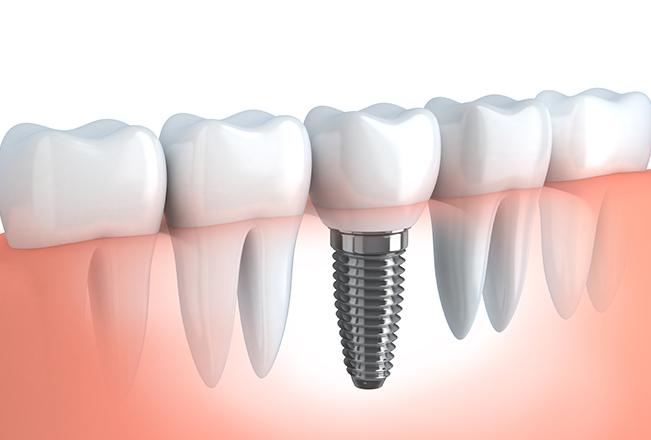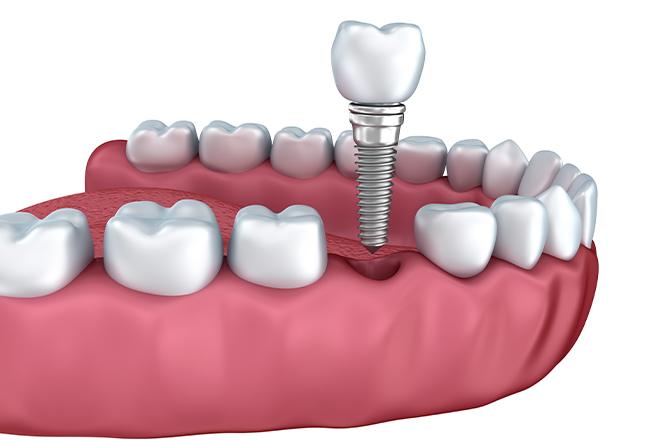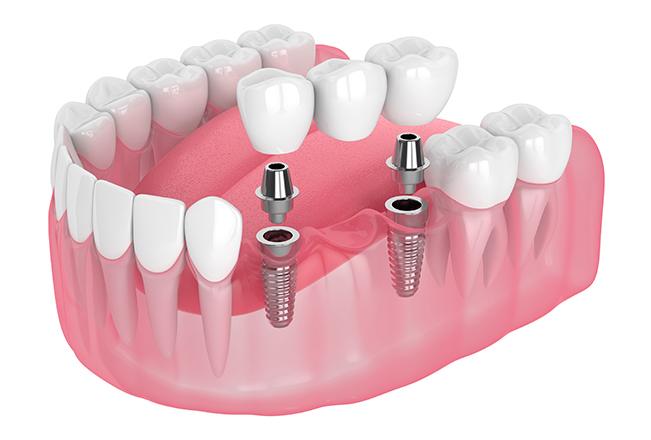So many of us believe that missing teeth makes a smile unattractive. Missing teeth are on display whenever we talk or smile; missing teeth can affect our self-esteem. If you are interested in an effective and permanent solution for one or more missing teeth, dental implants, and implant restoration might be right for you! With proper care, dental implants can be long-lasting, effective replacements for missing teeth that look, feel, and function just like your natural teeth. Let Sana Dental help you achieve the smile you have always wanted!

Your Choice For Dental Implants in North Edmonton, AB
What is a Dental Implant?
A dental implant is a small titanium steel post that is surgically inserted into your jawbone where missing teeth are, to act as an artificial tooth root. The implant is permanently fixed into the jaw bone and bonded to your bone, creating a very strong foundation on which to place your artificial tooth replacement. Once in place and healed, the implants are topped with an aesthetically pleasing dental crown. If properly cared for, dental implants can last for years. They are recommended for healthy patients with adequate bone levels in their jaw to support the dental implant.

Benefits of Dental Implants and Dental Implant Replacement
- Natural appearance of teeth: Missing teeth can affect your self-confidence. Dental implants can replace missing teeth to offer you the ability to smile with confidence again.
- Preserves surrounding structure of teeth: Dental implants prevent teeth from shifting and drifting from the space created by a missing tooth.
- Preserve Facial Structure: Underneath your teeth lies your alveolar bone. This is the ridge of bone that contains the tooth sockets. Below that is the jawbone proper. All bones need stimulation to maintain density. In the case of your alveolar and jawbones, this stimulation normally comes from your teeth. When teeth are missing, these bones can lose width, height, and volume. Since your teeth and jaws also act as the structural support for your face, jawbone loss can change its appearance causing that sunken “aged” look. Jawbone loss can also impair your ability to chew and speak.
- Better hygiene: Gaps left by missing teeth can be hard to clean, putting you at a higher risk for tooth decay and gum disease. Reliable
- High functioning
- Durable
- Long lasting: With proper care, and barring conditions that may damage your jawbone, a dental implant can last many years. The crown on the implant may need to be replaced after 10-15 years, but at that time, a new crown can be fabricated and placed on the same implant.
- Easy to care for
- Permanent solution
- Convenient: Eliminates the embarrassment and/or inconvenience caused when removing dentures
- Helps prevent cavities: Since implants are cavity-proof, your smile is less vulnerable to tooth decay.

What is The Dental Implant Process?
The first step in the dental implant process is to assess whether you are a good candidate. To do this, your dentist will discuss with you your general and oral health history. If you have advanced gum disease, some blood disorders, certain bone diseases, or poor-quality bone, you may not be a good candidate for dental implants in Edmonton.
To assess the state of your bone, a three-dimensional CBCT scan is often the tool of choice. It gives the dentist a detailed image of your jawbone, sinuses, and adjacent teeth, and helps with precise planning of your dental implant procedure, because it takes away any guesswork of where the implant should be placed. It will also help to determine if there is a need to add artificial bone material to an area where the bone density is compromised.
Once the implant is placed, it needs time to heal. As it heals, your jaw bone grows around it in a process known as osseointegration. This typically takes 4-6 months. During this time, the implant becomes an integral part of your body, as it fuses with your jawbone. Once osseointegration is complete, the implant is topped with a dental crown.
What If You Have More Than One Missing Tooth?
If you are missing more than one tooth, you may receive a dental bridge that is bonded to dental implants. This means that you do not need an implant for every single tooth, but you will still have fully functional and natural-looking replacements. These dental bridges are crafted without any wires, so they have an appearance nearly indistinguishable from a row of individual teeth.

If you are looking for a natural, permanent, and high-functioning restoration for replacing missing teeth, dental implants might be right for you. If you would like to learn more about dental implants or you would like to set up an appointment, call us at (780) 476-3391, and we will be happy to help!
We look forward to hearing from you soon!
Call us at (780) 476-3391 to set up your Dental Implants and Implant Restoration today!